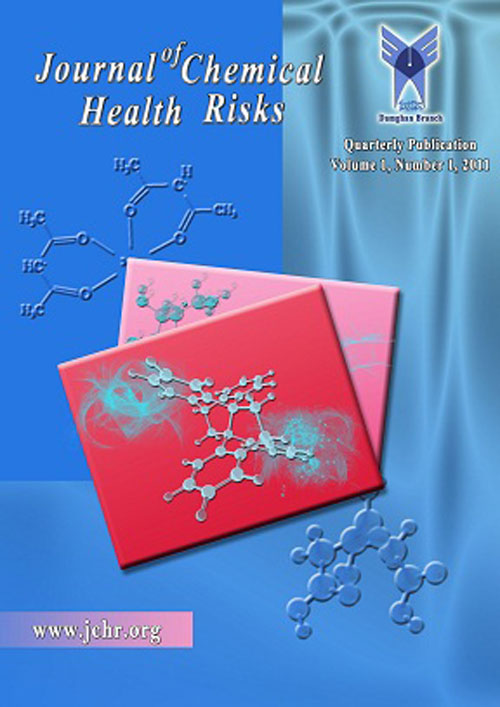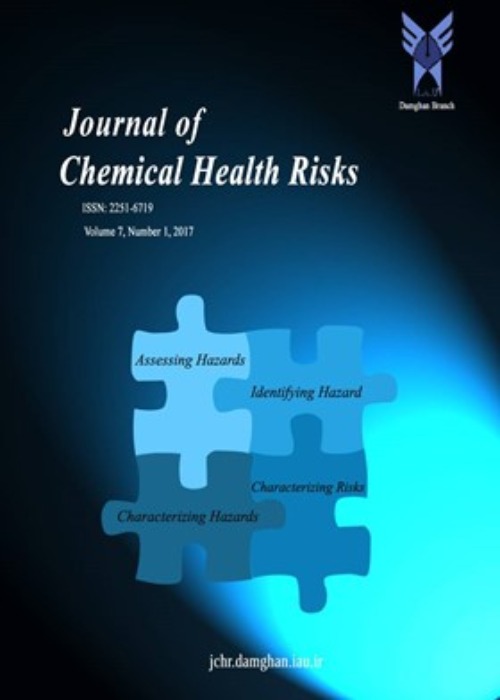فهرست مطالب

Journal of Chemical Health Risks
Volume:6 Issue: 1, Winter 2016
- تاریخ انتشار: 1394/12/06
- تعداد عناوین: 8
-
-
Page 1In this study, the concentrations of 25, 375 and 500 ml L-1 of Cola+ 2000 mg L-1 of peppermint essence and concentrations of 30, 45 and 60 ml L-1 of apple extract +2000 mg L-1 rosemary essence on Alstroemeria cut flowers (Cv. balance) were investigated to verify the use of natural ingredients in flowers preservative solutions. This experiment was conducted in the laboratory of Gorgan University of Agricultural Sciences and Natural Resources, in 2014. Results showed that the interaction of cola with peppermint essence and apple extract with rosemary essence at above concentrations increase the vase life of flower, flower diameter and anthocyanin at significantly level of %1. The highest amount of vase life was related to concentration of 500 ml L-1 of cola (15 days), while vase life in control treatment (distilled water) was 9 days. The highest flower diameter was recorded in apple extract (45 ml L-1) + Rosemary essence (2000 mg L-1). The highest amount of anthocyanin was obtained in cola treatments of 500 ml L-1+ essence of peppermint, 30 and 45 ml L-1 of apple extract+ rosemary essence. Besides, flowers treated by 375 ml L-1 of cola + peppermint essence had the highest chlorophyll content. Generally, the results showed that treatments used in this experiment, as accessible compounds are healthy and non-hazardous for the environment, appropriate to increase the vase life of Alstroemeria cut flowers.Keywords: Alstroemeria, Natural compounds, Non, hazardous, Vase life
-
Page 9The purpose of this study was to investigate the hypothesis weather the combination of lead acetate and deltamethrin can enhance avian toxic effects produced by lead exposure only. Overall, 48 Japanese quails, Coturnix coturnix Japonica (15 day old) were randomly divided into 4 experimental groups of 12 birds each and sex ratio of 1:1. Experimental groups consisted of control Japanese quails, birds exposed to a single dose of lead acetate and lead acetate combined with sub-lethal doses of deltamethrin (0.25 and 0.50 mg. kg-1 diet) for 21 days. We studied the effects of a single dose of lead acetate, combined with deltamethrin, on survival and blood biochemical parameters of Japanese quails. The results revealed a significant increase in plasma AST and ALT activities, glucose, uric acid and creatinine levels after feeding quails with contaminated diet (P <0.05). There was a significant increase in CPK and LDH activities and triglyceride levels in the blood of quails fed diets contaminated with a combination of lead acetate and deltamethrin (P <0.05). The decrease in AChE and ALP activities, total protein, and globulin was observed in plasma of quails fed contaminated diets. There were no significant changes in albumin levels. Although oral administration of lead acetate combined with 0.25 mg deltamethrin caused a significant increase in cholesterol levels, no significant differences were observed in triglyceride levels in other treatments. The synergic effects of deltamethrin on the alterations in the blood biochemical parameters of quails exposed to lead highly depend on the concentrations of this pesticide in feedstuffs.Keywords: Deltamethrin, Lead acetate, Blood biochemical parameters, Japanese quail
-
Page 23In this study, residual amount of pentachlorophenol (PCP) as the most important paper preservative, which is extremely hazardous pollutant, was determined in some tissue papers and napkins. Twenty-five samples of two producing hygienic paper factories prepared from virgin and secondary pulp were analyzed for the presence of trace amount of PCP. The analytical procedure involved direct extraction of PCP from hygienic paper and its determination by gas chromatography with electron capture detection. The statistical results for the analysis of all samples revealed that there were significant differences between mean of PCP in hygienic papers prepared from virgin and secondary pulp (P<0.05). This method gave recoveries of 86-98% for hygienic paper made from virgin pulp and 79-92% for hygienic paper made from secondary pulp. The limit of detection (LOD) and limit of quantification (LOQ) for PCP were 6.3 and 21.0 mg/kg, respectively. The analytical method has the requisite sensitivity, accuracy, precision and specificity to assay PCP in hygienic papers. This study demonstrates a concern with exposition to PCP considering that hygienic paper is largely consumed in the society.Keywords: Contamination, Pentachlorophenol, Secondary pulp, Hygienic paper, Toxicity
-
Page 33As part of our ongoing interest in exploring the synthesis of antibacterial agent, we report an efficient, mild, one pot and chemoselective procedure for preparation of 3-poly (vinylbenzyl)-5,5-dimethylimidazolidine-2,4-dione as a antimicrobial agent from pol (vinylbenzyl chloride) and 5,5-dimethylhydantoin in the presence of a base in DMF as a solven. The FT-IR technique and melting point confirmed the desire product. Then, 3 poly (vinylbenzyl)-5,5-dimethylimidazolidine-2,4-dione nanofibers was produced by electrospinning process. To confirm the nanofiber materials, SEM image was applied. Then, these nanofibers were, chlorinated with sodium hypochlorite. Finally, the antibacterial activity of synthesized nanofibers was evaluated by against Staphylococcus aureus as gram-positive bacteria and Escherichia coli as gram-negative bacteria. The results from culture media and halo diameters of nanofibers showed that high biocidal effect of fibers against these bacteria. These nanofibes could be used in order to construct filters needed to clean and disinfect drinking water in emergency.Keywords: N, halamine nanofibers, Electrospinning process, Antimicrobial agent, Antibacterial activity, Decontamination
-
Page 41Heavy metals entrance to fish body tissues and transferring to human body systems after their consuming makes numerous undesirable effects and health problems. The aim of this study was to determine some heavy metals (lead, cadmium and mercury) in fresh fishes marketed in Khorramabad City, west of Iran. In this descriptive study, five samples of 17 fish species with high consumption were purchased randomly in 2014. Measurement of mercury, lead and cadmium was performed using atomic absorption spectrometry. All measurements were performed three times for each sample. Lead mean levels in fish samples was in the range 0.736 -1.005 ppm, cadmium range was from 0.196 to 0.015 ppm and mean content of mercury was 0.431 - 0.107 ppm. At present mean concentration of lead, mercury and cadmium in supplied fishes muscle is lower than maximum recommended levels according to WHO, EC and FDA guidelines. Based on the obtained results of this study and the importance of heavy metals in foods and their impacts on human health, continuous monitoring of heavy metals levels in foods is necessary.Keywords: Fish, Heavy metals, Iran
-
Page 49A robust and reliable quantitative structure-property relationship (QSPR) study was established to forecast the melting points (MPs) of a diverse and long set including 250 drug-like compounds. Based on the calculated descriptors by Dragon software package, to detect homogeneities and to split the whole dataset into training and test sets, a principal component analysis (PCA) approach was used. Accordingly, there was no outlier in the constructed cluster. Afterwards, the genetic algorithm (GA) feature selection strategy was used to select the most impressive descriptors resulting in the best-fitted models. In addition, multiple linear regression (MLR) and support vector machine (SVM) were used to develop linear and non-linear models correlating the molecular descriptors and the melting points. The validation of the obtained models was confirmed applying cross validation, chance correlation along with statistical features associated with external test set. Our computational study exactly showed a determination coefficient and of 0.853 and a root mean square error (RMSE) of 11.082, which are better than those MLR model (R2=0.712, RMSE 15.042%) accounting for higher capability of SVM-based model in prediction of the theoretical values related to melting points. In fact, using the GA approach resulted in selection of powerful descriptors having useful information concerning effective variables on MPs, which can be utilized in further designing of drug like compounds with desired melting points.Keywords: Melting point, QSPR, Genetic algorithm (GA), Support vector machine, Multiple linear regression, Molecular descriptors
-
Page 69
Today, biosphere pollution has accelerated strongly with start of industrial revolution by toxicity of heavy metals. One of existing pollution is soil pollution. Unfortunately, soil pollution by metals is as intensive environmental stress for plant hence for human. Plants,which are able to store heavy metals in their organs, can be used for phytoremediation of polluted soils and utilization of these plants is effective for phytoremediation as a cheap and economic method. In this research, the absorption rate of Cd (II), Ni (II) by Descurainia sophia was considered in hydroponic conditions. Plants were grown in Hoagland media containing different concentrations of Cd (II), Ni (II). An experiment in a completely randomized design with three replications was conducted. Two weeks after treatment of plants the sample were gathered and metal concentration was measured by atomic absorption spectroscopy. Besides, the content of chlorophyll and proline was measured. The results showed the chlorophyll content in high concentrations of the metals (Cd (II), Ni (II)) was decreased in plants that were sign of pigment degradation in presence of heavy metals. Similarly, the proline content in plants was increased under stress which was sign of damage of heavy metal stress on plant and activation of defensive mechanisms in this condition. The effects of toxic concentration of nickel and cadmium on metal accumulation in these plants showed that roots were able to absorb more than shoots, which is sign of elements connection to root cell wall.
Keywords: Phytoremediation, Accumulator's Species, Excluders Species, Soil Pollution, Cadmium, Nickel, Descurainia sophia L -
Page 79Relatively high levels of radon emissions are associated with particular types of rocks such as granites. Because of chemical composition of granite, it sends out radioactive radiations. In recent years, regardless of its hazards demand have increased for these stone types. In this paper, health hazards of granite were assessed in terms of its radon gas emission. The radon gas was analyzed in samples collected from Buien- Miyandasht`s granite mass in Isfahan Province, central Iran. The result of this survey shows that radon content in some local stones used as basements are extremely high and these samples are main sources of indoor radon emanation.Keywords: Building stones, Granite, Iran, Buien's mass, Radon


